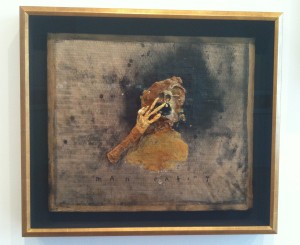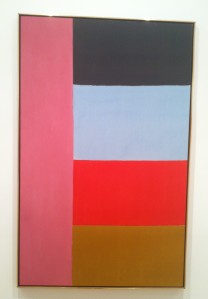Lutz Bacher @ Alex Zachary Peter Currie Gallery
Lutz frames pages shorn from books and hangs them up on the wall as if they were pictures. This page, the first thing one sees upon stepping into the AZPC Gallery, is about cosmology. The header reads, “Fundamental Knowledge for the Observer.” One claim made for the searcher of things is that the odds of locating an Earth-size object in the universe are about as likely as finding a particular grain of dust lost somewhere on the North American continent.
This is something to meditate on downstairs where Lutz has filled the gallery as well as the outside courtyard with sand. The tracks of past visitors are scattered here and there amidst the little dunes. I take off my shoes and meander barefoot; nothing compliments thoughts of infinite possibility quite so well as a tactile sensation between one’s toes.
In the background there is a lilting soundtrack of twangy string instruments, the sort of music you might find in a massage parlor. A voice asks, “what are you thinking,” another responds, “how happy I am.” Both sound sedated. Back upstairs four television monitors sit on the floor displaying monotones of blue and grey. The screens flicker and if you lie down on your belly and stare, they are really quite calming.
In an adjacent room there this a photograph of a black school bus with a painting of a galaxy on its side. On a low table sit stacks of white t-shirts with the front half of self-help statements printed across their fronts, “what I needed from my mother and didn’t get was,” or, “I am a person who.” A video of an unedited conversation between a man and a woman rolls along. I sit and watch. The camera must have been left on the table, as if it were a voice recorder, because all you get to see is a knit sweater and a hand that occasionally reaches for a coffee cup.
Parts, snippets, fragments—this is how we experience everything. Wholeness is an illusion generated by the reflective division of the intellect. Wholeness takes time, occurs over time, but what about the wholeness of the integral component? Sooner or later you have to find a point where divisibility is no longer possible, right? Or would that simply signal the inadequacy of the tools one was using to split and measure?
David Lynch @ Jack Tilton Gallery
Boom! First piece to come into view is a large mixed media work in a handsome frame of a long limbed person blowing off his or her head. From there it gets weirder and weirder, but if it didn’t I think I’d be a little disappointed. After all, Lynch is the reigning king of surrealism and subconscious dream fantasies exploding violently into reality. Self-mutilation in the form of eye gouging and arm chopping recurs, as do depictions of matches and things being lit on fire by them. Lynch’s raw material—he uses cardboard to great effect, as well as plywood that is itself scored and charred—is imbued with the same injured aesthetic of much of his subject matter.
This is physical stuff. His figures, formed of goop and stick, protrude from the surface like bones through skin. It’s unsettling, and if it wasn’t in a fancy gallery it might be frightening. There is also a thirty-second film of an egg that hatches an insect on a stage, and series of black and white photographs that could be the result of negatives collaged in a dark room. Attempting to define these images is like trying to recall a dream upon waking; you have a sense of it, a feeling even, but the edges of the form won’t come into focus. Whatever it is, it retains the mystery of its presence.
Jack Bush @ Freedman Gallery
There are few flat surfaces as pleasing to the eye as the paintings of colorist illuminated in the afternoon sun. It’s as if they were made for this light. Especially Jack’s paintings, they are washy and weightless—about the opposite of those pictures made by his moody contemporary Mark Rothko. There is not a trace of anxiety or restlessness in Jack’s paint handling, nor is there a dark hue or a primary color in his palette. Edges are precise without being mechanically so, and where there are forms, they appear as natural and at ease as a duck on a pond.
I spent most of my time with two paintings in particular. In the first I was attracted to the scumbled technique of the pink-toned undercoat. It reminded me of a skinned knee, stained particleboard, marbled fat, an airplane view of a flesh ocean; and on top of this layer Jack’s painted a series of curved dashes in different colors like musical notes on a score. Each of these brush strokes has a ragged edge that gives them a splintered look, or the appearance of colors quickly, even spontaneously applied. And the way these strokes bunch together and slink apart, you’d think Jack was recording the movement of an earthworm.
The other painting I gravitated towards was perhaps the simplest of the lot. Five non-overlapping rectangles of color occupy the entire surface. There is nothing zippy, no background or foreground—just blocks of blue, pink, grey, red, and ochre. It’s a mind-clearing artwork that just seems sturdy. There isn’t a curved line in the entire composition; in fact, it’s about as organic and natural looking as the checkerboard landscape of the Midwest. Still the feeling this picture stirs in me is one of serenity, like sitting poolside on a summer day, buoyant and carefree, not because I have no cares but because I can get inside a moment where they exist free of any need to be attended to.






